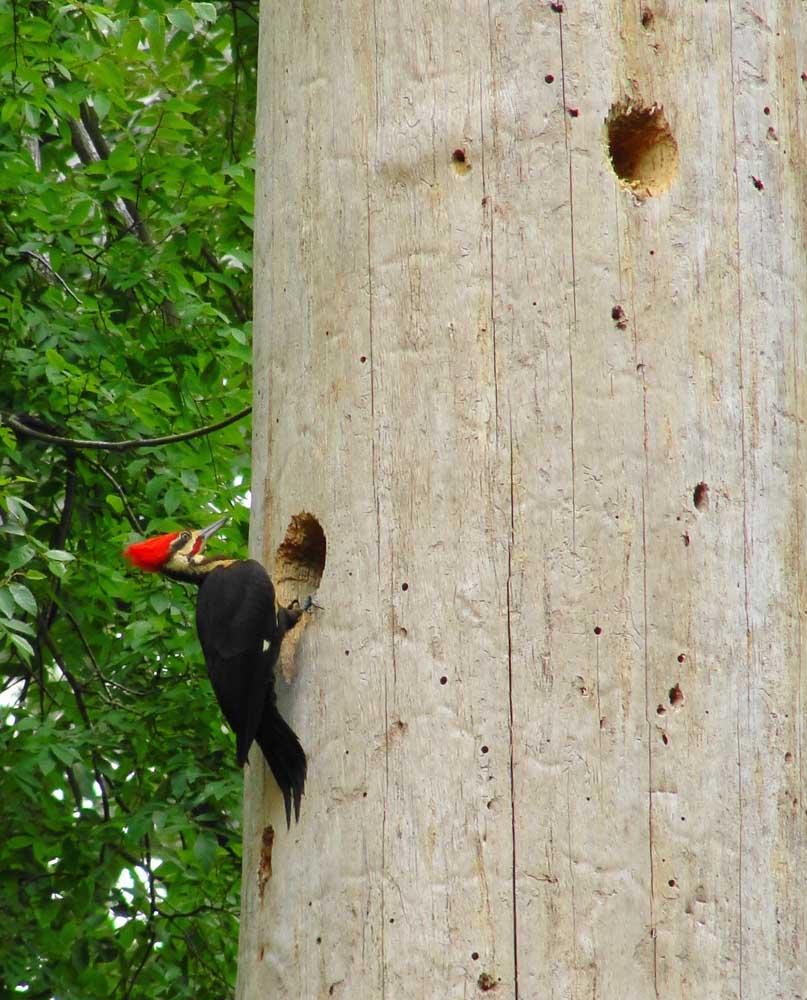The hole truth about cavity-dwelling birds
Published 8:15 pm Tuesday, May 11, 2021

- A male pileated woodpecker excavates a nesting cavity in a dead loblolly pine.
I love growing stuff. But I also love bees, bugs, bats, butterflies and birds. A picture isn’t complete with just the plants. When it comes to birds, I have to admit that I have my favorites. One group that I’m partial to is cavity-dwellers.
You are probably familiar with a number of cavity-dwelling birds such bluebirds, chickadees, martins, nuthatches, titmice and wrens. Others include flycatchers, kestrels, owls, and wood ducks. These are all known as secondary cavity dwellers since they can’t create their own nesting cavities in trees.
Woodpeckers are primary cavity dwellers since they are the only birds that can carve out their own nesting cavities. Thankfully, they create both nesting and roosting cavities each year, and with the exception of the red-cockaded woodpecker, don’t reuse them. This provides plenty of free homes for all the secondary cavity dwellers, some 85 species in the United States.
There have been 16 species of woodpeckers recorded in Texas, 9 in East Texas. These include the downy, hairy, northern flicker, yellow-bellied sapsucker, red-bellied, red-headed, and pileated woodpeckers. Unfortunately the red-cockaded woodpecker is endangered and the ivory-billed woodpecker most likely extinct.
My favorite woodpecker to look at is the striking red-headed woodpecker. My favorite one to listen to, however, is the pileated woodpecker. From the first time, I heard one as a child in Longview, I was hooked. Although woodpeckers were naively once thought of as detrimental to trees and forests, it turns out to be the exact opposite.
Woodpeckers are what are known as a “keystone species.” Keystone species are those that are critical in creating habit for other wildlife. Woodpeckers don’t just create homes. They also manage tree-killing insects while spreading the seeds from fruits and berries that they eat. Woodpeckers are also indicators of healthy ecosystems. A diverse woodpecker population indicates a matrix of old trees, young trees, insects, fruits, nuts, and of course, secondary cavity dwellers like bluebirds and nuthatches.
There’s a simple recipe for having woodpeckers and the benefits that come with them. Leave dying and dead trees standing when you can. These are called “snags” in the forestry world and are imperative to having both primary and secondary cavity dwellers. We certainly aren’t going to leave dead trees next to our houses, sheds, or cars; but we can leave them on rural properties, woodlands, and vacant lots.
Those in urban backyards, parks, cemeteries, and golf courses can also have all their limbs and tops taken off, leaving standing dead trunks for woodpecker foraging and excavating.
Never forget that before humans arrived, purple martins and bluebirds existed and nested successfully thanks primarily to woodpeckers and their cavities.
If you’d like to learn more about the woodpeckers of East Texas plan to attend the final zoom lecture of the Smith County Master Gardeners award-winning “Master Gardeners at the Library” where I’ll be presenting “The Hole Truth: the Woodpeckers of East Texas.” The presentation is Friday May 21 at 11:30 am.
For the Zoom link go to the Smith County Master Gardener website https://txmg.org/smith/coming-events/.
For more information, call 903-590-2980 or visit the Smith county Master Gardener’s Facebook page or website.
Greg Grant is the Smith County horticulturist for the Texas A&M AgriLife Extension Service. He is author of Texas Fruit and Vegetable Gardening, Heirloom Gardening in the South, and The Rose Rustlers. You can read his “Greg’s Ramblings” blog at arborgate.com, read his “In Greg’s Garden” in each issue of Texas Gardener magazine (texasgardener.com), and follow him on Facebook at “Greg Grant Gardens.” More science-based lawn and gardening information from the Texas A&M AgriLife Extension Service can be found at aggieturf.tamu.edu and aggie-horticulture.tamu.edu.






